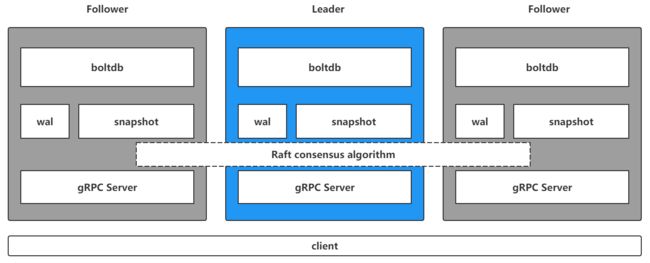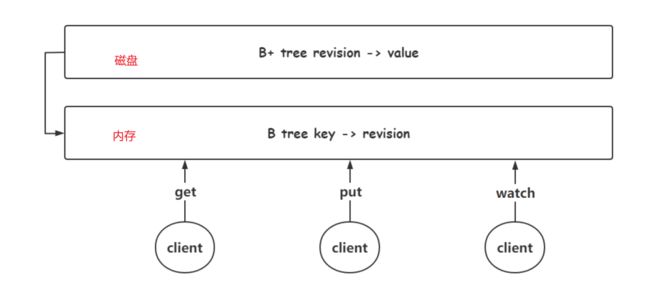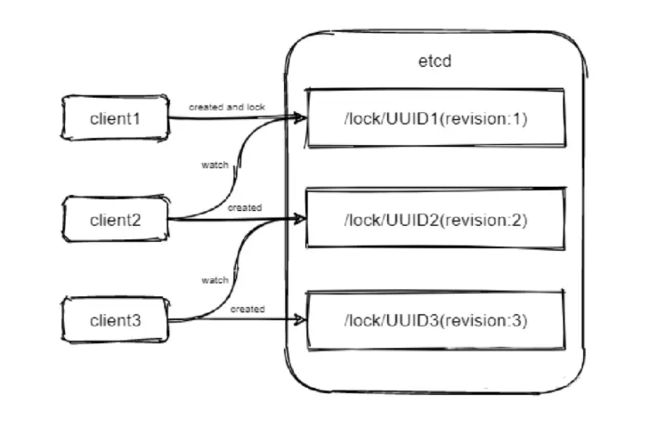服务注册中心etcd
etcd简介
etcd官方描述
A distributed, reliable key-value store for the most critical data of a distributed system.
etcd is a strongly consistent, distributed key-value store that provides a reliable way to store data that needs to be accessed by a distributed system or cluster of machines. It gracefully handles leader elections during network partitions and can tolerate machine failure, even in the leader node.
etcd提供一个分布式,高可用、强一致性的kv数据存储服务;
用于读多写少的场景,用于存储少量数据;etcd诞生于CoreOS公司,基于go语言实现,主要用于共享配置和服务发现;
etcd v2和v3版本比较
- v2版本使用http1.1+json通信,v3版本使用grpc(http2.0)+protobuf;v3也支持http+json;
- v2是简单的kv内存数据库;v3支持事务和多版本并发控制(一致性非锁定读)的磁盘数据库;
- v3使用lease(租约)替换key ttl自动过期机制;
- v3是扁平的kv结构;v2是类文件系统的存储结构,是树状的,跟zookeeper类似;
etcd架构
grpc Server:etcd集群节点间以及clent与etcd节点间都是通过grpc进行通信;
Raft协议:etcd通过raft协议来管理集群;
wal(write ahead log):预写式日志,执行写操作前先写wal日志,磁盘顺序写,提升写性能;类似mysql的redo log和rocksdb的wal日志;
snapshot快照数据:用于其他节点同步主节点数据从而达到一致性的状态;类似redis的rdb,用于主从同步;
boltdb:是一个单机的支持事务的kv数据库,etcd的事务是基于boltdb的事务实现的;boltdb为每一个key都创建一个B+树,该B+树存储了key所对应的版本数据;
etcd操作命令
设置
# Puts the given key into the store
PUT key val
--ignore-lease[=false] #updates the key using its current lease
--ignore-value[=false] #updates the key using its current value
--lease="0" #lease ID (in hexadecimal) to attach to the key
--prev-kv[=false] #return the previous key-value pair before modification
删除
# Removes the specified key or range of keys [key, range_end)
DEL key
DEL keyfrom keyend
--from-key[=false] #delete keys that are greater than or equal to the given key using byte compare
--prefix[=false] #delete keys with matching prefix
--prev-kv[=false] #return deleted key-value pairs
获取
# Gets the key or a range of keys
GET key
GET keyfrom keyend
--consistency="l" #Linearizable(l) or Serializable(s)
--count-only[=false] #Get only the count
--from-key[=false] #Get keys that are greater than or equal to the given key using byte compare
--keys-only[=false] #Get only the keys
--limit=0 #Maximum number of results
--order="" #Order of results; ASCEND or DESCEND(ASCEND by default)
--prefix[=false] #Get keys with matching prefix
--print-value-only[=false] #Only write values when using the "simple" output format
--rev=0 #Specify the kv revision
--sort-by="" #Sort target; CREATE, KEY, MODIFY, VALUE, or VERSION
-w json
监听
# Watches events stream on keys or prefixes
WATCH key
-i, --interactive[=false] #Interactive mode
--prefix[=false] #Watch on a prefix if prefix is set
--prev-kv[=false] #get the previous key-value pair before the event happens
--progress-notify[=false] #get periodic watch progress notification from server
--rev=0 #Revision to start watching
事务
保证多个操作的原子性;
# Txn processes all the requests in one transaction
TXN if/ then/ else ops
-i, --interactive[=false] #Input transaction in interactive mode
租约
lease grant # 创建一个租约
lease keep-alive # 续约
lease list # 枚举所有的租约
lease revoke # 销毁租约
lease timetolive # 获取租约信息
raft共识算法
raft是一种分布式一致性算法;
tikv server通过raft算法保证数据的强一致性;pd server也是通过raft来保证数据的一致性;
Raft下读写是如何工作的?
读写都是通过leader;follower只有选举和备份的作用,读写都不经过follower;learner只有复制的作用,没有选举权;
leader选举(leader election)
两个超时控制选举:
- election timeout, 选举超时,就是follower等待成为candidate的时间,是150ms到300ms的随机值;
- heartbeat timeout,心跳超时,要小于150ms,即小于election timeout;
选举超时后,follower成为candidate,开始新一轮选举,election term(任期)加一;follower给自己投上一票,然后向其它节点拉票;如果其他节点还没有投票,那么就投给这个candidate;收到拉票请求后,其它节点重置它的选举超时;candidate获得大多数的选票的时候,就成为leader。leader在心跳超时(heartbeat timeout)内,向其它节点同步自身的变化,follower节点收到通知后给leader回复;当前选举周期一直持续到某个follower节点收不到heartbeat,从而成为candidate。
follower成为candidate后,需要做以下事情:
- election term加一;
- 给自己投一票;
- 重置election timeout;
follower收到拉票请求后,需要做以下事情:
- 重置election timeout;
- election term加一
- 只会给第一个拉票的candidate投票;
收到heartbeat也需要重置election timeout;
日志复制(log replication)
所有的写操作,都需要通过leader节点;leader先将写操作写入log(WAL日志),并没有提交;之后将log发送给follower节点,follower节点会写入自己的WAL日志,之后回复leader节点;leader节点获得大多数节点的应答后,再进行提交,之后将结果回复给client;最后再通知follwer节点落盘;
网络分区(network partitions, 脑裂)
比如集群一共有5个节点,由于网络故障,分成两个分区A, B;A有3个节点,B有2个节点,原先的leader节点在B中,A会重新选举出一个新的leader;对于A的写操作,由于大多数原则,最终会commit;对于B,因为不满足大多数原则,所以不会commit。
网络恢复后,raft如何恢复一致性?
网络恢复后,B会回滚未提交的日志,并且会同步A的数据;主要是因为A的election term比B大,最终A中的leader会成为整个集群的leader;election term的作用?
解决网络分区问题;
etcd存储原理
数据版本号机制
- raft_term:
leader任期,没进行一轮选举term加一;全局递增,64bits;
- revision:
etcd 全局key空间版本号,只要有key发生变更,则revision加一;
revision机制是etcd实现MVCC的基础;
- kv中的revision:
- create_revision
创建key数据时,对应的revision;
- mod_revision
修改key的value数据时,对应的revision;
- version
key的当前版本号;表示该key的value被修改了多少次;
etcd存储
etcd为每个key创建一个索引;在磁盘中,使用B+树存储,一个索引对应一棵B+树;B+树的key为revision,value为key对应的值;B+树存储key的revision,从而实现了etcd的MVCC;etcd不会存储所有的revision,会通过定期compaction来清理历史revision,只保留较新的部分revision;
为了提高索引的效率,etcd在内存中维持一棵B树;为什么使用B树,而不是红黑树呢?从磁盘B+树中,可以一次copy一页(16k)到内存B树中,插入效率更快;
mysql通过undolog实现MVCC;mysql内存使用自适应hash
etcd应用
服务发现
etcd作为注册中心;服务提供者向etcd进行注册,即put key value;服务使用者watch对应的key;
负载均衡
多个服务提供者向etcd进行注册,put不同的key,使用同样的prefix;etcd通过心跳检测,确定各个服务提供者的状态,进行负载均衡;
分布式锁
redis可以通过setnx实现非公平分布式锁;etcd可以实现平台锁;
第一个创建key的客户端先获取锁;其他客户端监听版本号刚好小于自己的对象的删除信息;





